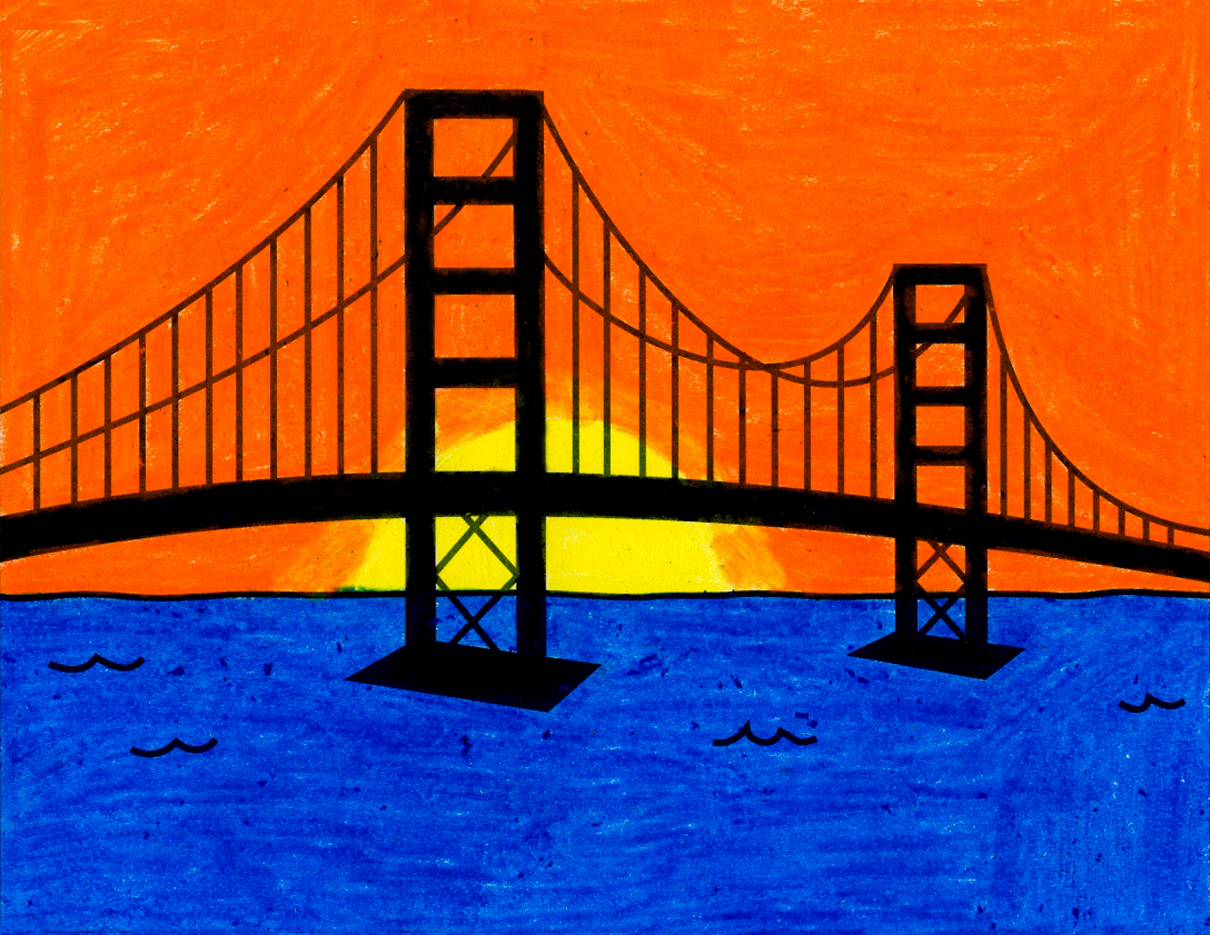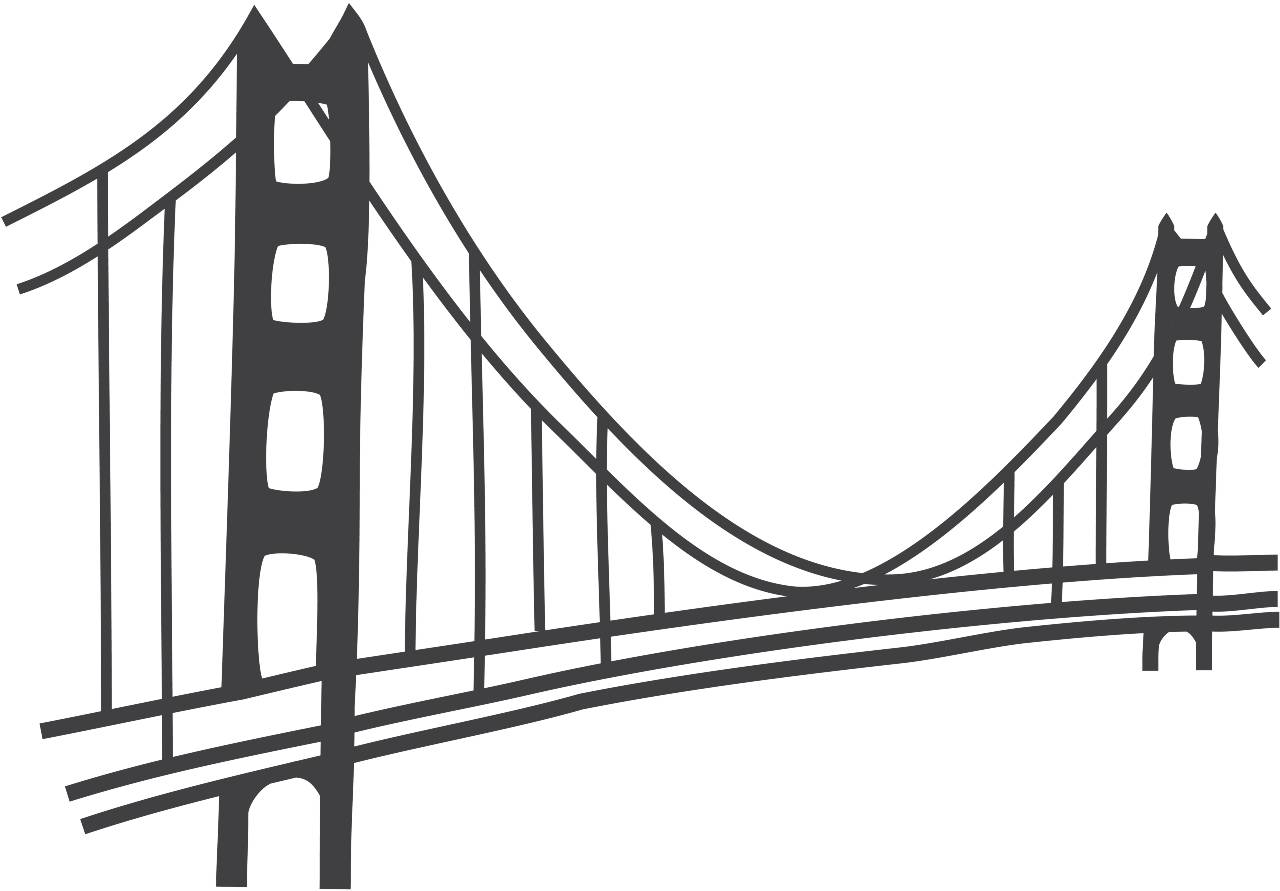
Source: https://artprojectsforkids.org/how-to-draw-the-golden-gate-bridge/
The Golden Gate Bridge is iconic and beautiful, and many people want to know how to draw it, but it certainly isn’t an easy thing to draw well. The different supports and mix of curves and straight lines make it a challenging sketch for most people.
You Will Need:
- Some plain paper
- A sharp pencil
- A pencil sharpener
- An eraser
- A ruler
- A fineliner
Step 1: Divide Your Paper Into Four
First, let’s add some faint guides. Using your ruler, find the center of the paper and pencil in both a horizontal and a vertical line. You can also fold the paper in half both ways and lightly crease, but this will affect the final picture a bit. Having a division will help you to draw straight, even lines.
Step 2: Draw The Arch
Going right across the sheet of paper, draw a gentle arch, just below your horizontal guide.Next, draw another one almost parallel. Your second one should narrow just a little at the right-hand side to allow for perspective, and be slightly wider on the left-hand side. If possible, it should also touch the central guide at its highest point.This is the bottom of the bridge.
Step 3: Draw Two Supports
Using your ruler, draw two thin, vertical, rectangular supports just left of your central guide. Make one support just slightly higher than the other to give a sense of perspective. These supports should be drawn standing on an angled rectangle, in the bottom left square of your paper. They will bisect your arch.Once you’re happy with that, it’s time to add the details of the supports. Start at the top and draw a line between the two supports, followed by another line. This is the top strut of the support.You are going to draw four of these in total. To get the spacing right, draw the bottom one next; this should go a little above the arch. Draw two horizontal lines, a short distance apart, as you did for the top support.Next, fill in the final two supports in the space between the top and the bottom one. You may need to erase in places to try and get them even; there should be approximately the same gap between each support, and between the bottom support and the arch of the bridge. It doesn’t need to be perfect, though!Move onto the crosses at the bottom of the bridge. You are going to draw two “X” shapes between the rectangle at the base of your supports and the top line of your arches.Mark the halfway point and then draw an “X” in each half.
Step 4: Draw The Second Supports
About halfway across your right-hand squares, you are now going to repeat the above instructions, but about a third smaller. You want the base of your secondary supports to be a little higher than your first ones, but the top should finish a good bit lower.Otherwise, the supports should be identical, so use the same process for drawing them; the only change is that everything should be smaller to allow for perspective.
Step 5: Draw In The Cable Lines
Put your pencil to the left edge of the paper, a little above your horizontal halfway line. Draw a gentle curve up to the top of the right-hand support.Draw the second cable a little above this one, at approximately the same trajectory. It does not need to match and may look better if you draw it slightly straighter.Now it’s time to join the first support to the second one. Start on the right-hand support; you’re going to join it to the next right-hand support. Draw a curving line that dips down to about the third horizontal bar on the second support, and then sweeps back up to meet its top. You should aim to have the lowest point about two-thirds of the way along the line.This will give you a long downward, almost straight line from the first support, and a steep curve sweeping up to meet the second support.Next, turn to the left-hand supports. You can either draw from the top of the first left-hand support, or between its two central horizontal struts; it will just look like the line is hidden behind the rest of the supports.Draw a shallower and more even curve to the second left-hand support. This should cross the other cable, enhancing the perspective.Finally, draw a sloping curve from the smaller right-hand support to the edge of the paper, dipping down lower than either of your other four cables.
Step 6: Draw Vertical Lines
Use your ruler to mark and draw evenly-spaced vertical lines between the arch and the highest cable right along the bridge. Do not draw them in front of your supports, but otherwise continue all the way along with the picture, representing the ropes that go from the cables to the bridge.It doesn’t matter if the lines seem to join up to different cables; this will enhance the perspective. Don’t try to draw vertical lines for both cables, as this will look messy.
Step 7: Erase, Detail, And Fineline
Erase any lines you are unhappy with, including your guidelines; you’ve finished with those. Add a water line and some waves a little above the structural supports; this should run straight across your paper and not conform to the perspective lines. Draw freehand so you get a natural waviness to it.Add a few little waves or other details, and then Fineline your picture to finish it.
Conclusion
Your Golden Gate Bridge is now finished! If you’ve used a ruler, you should have a good mix of straight lines and smooth curves to reflect the bridge’s iconic shape. If there’s anything you’re uncertain about, try bringing up a picture of the bridge to help you draw more accurately and understand the shapes.You can draw a simpler version of this picture without the perspective, but adding a bit of depth will make it look better and is a good opportunity to practice the challenges that perspective presents. Your Golden Gate Bridge drawing is complete!
Comments
0 comments



